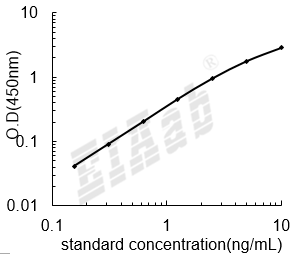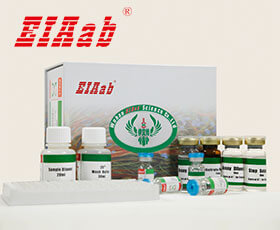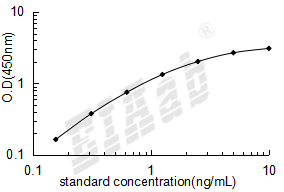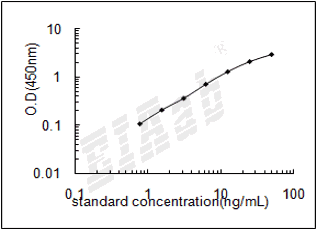NLrp3 (基因名), NACHT, LRR and PYD domains-containing protein 3 (蛋白名), nlrp3_rat.
产品名称:
Rat NLrp3/ NACHT, LRR and PYD domains-containing protein 3 Recombinant Protein
含NACHT、LRR和PYD结构域的蛋白3
货号:
R14531r
商标:
EIAab®
监管等级:
别名:
Cold autoinflammatory syndrome 1 protein homolog, Cryopyrin, Mast cell maturation-associated-inducible protein 1, PYRIN-containing APAF1-like protein 1, Nalp3, Pypaf1
序列号:
D4A523
来源:
E.coli
种属:
Rat
标签:
His
序列:
21-212aa
预估分子量:
21.12 kDa (monomer)
纯度:
Greater than 90% by SDS-PAGE
浓度:
Reconstitution Dependent
形态:
Liquid
内毒素水平:
Please contact protein@eiaab.com The technician for more information.
应用:
存储缓冲液:
50mM NaH2PO4, 500mM NaCl Buffer with 500mM Imidazole, 10%glycerol(PH8.0)
存储:
Store at -20°C. (Avoid repeated freezing and thawing.)
研究领域:
-
R&D 技术数据
Recombinant rat NLrp3 protein was determined by 12% SDS-PAGE stained with Coomassie Blue under reducing conditions.
通用注释
亚单元:
Sensor component of NLRP3 inflammasomes. Inflammasomes are supramolecular complexes that assemble in the cytosol in response to pathogens and other damage-associated signals and play critical roles in innate immunity and inflammation. The core of NLRP3 inflammasomes consists of a signal sensor component (NLRP3), an adapter (ASC/PYCARD), which recruits an effector proinflammatory caspase (CASP1 and, possibly, CASP4 and CASP5). Within the complex, NLRP3 and PYCARD interact via their respective pyrin domains. This interaction initiates speck formation (nucleation) which greatly enhances further addition of soluble PYCARD molecules to the speck in a prion-like polymerization process. NLRP3 localizes at the end of each PYCARD filament. Clustered PYCARD nucleates the formation of CASP1 filaments through the interaction of their respective CARD domains, acting as a platform for CASP1 polymerization. CASP1 filament formation increases local enzyme concentration, resulting in trans-autocleavage and activation. Active CASP1 then processes IL1B and IL18 precursors, leading to the release of mature cytokines in the extracellular milieu and inflammatory response. Reconstituted ternary inflammasomes show star-shaped structures, in which multiple filaments, containing CASP1, protrude radially from a single central hub, containing the sensor protein and PYCARD. In this complex, the sensor protein is sub-stoichiometric to PYCARD, and PYCARD is further substoichiometric to CASP1, suggesting amplifications of signal transduction from the sensor, via the adapter, to the effector (By similarity). Interacts with MEFV; this interaction targets NLRP3 to degradation by autophagy, hence preventing excessive IL1B- and IL18-mediated inflammation (By similarity). Interacts with GBP5 (via DAPIN domain); this interaction promotes inflammasome assembly in response to microbial and soluble, but not crystalline, agents (By similarity). Interacts with EIF2AK2/PKR; this interaction requires EIF2AK2 activity, is accompanied by EIF2AK2 autophosphorylation and promotes inflammasome assembly in response to specific stimuli. Interacts with PML (isoform PML-1) (via the LRR region); PML-mediated increase in NLRP3 inflammasome activation does not depend upon this interaction. Directly interacts with IRF4 (via LRR region); this interaction is required for optimal IRF4 binding to IL4 promoter and efficient IL4 transactivation during differentiation of Th2 helper T-cells (By similarity). Interacts (via NACHT domain) with DHX33 (via DEAH box) (By similarity). Interacts with PYDC5 (By similarity).
功能:
As the sensor component of the NLRP3 inflammasome, plays a crucial role in innate immunity and inflammation. In response to pathogens and other damage-associated signals, initiates the formation of the inflammasome polymeric complex, made of NLRP3, PYCARD and CASP1 (or possibly CASP4/CASP11). Recruitment of proCASP1 to the inflammasome promotes its activation and CASP1-catalyzed IL1B and IL18 maturation and secretion in the extracellular milieu. Activation of NLRP3 inflammasome is also required for HMGB1 secretion (By similarity). The active cytokines and HMGB1 stimulate inflammatory responses. Inflammasomes can also induce pyroptosis, an inflammatory form of programmed cell death. Under resting conditions, NLRP3 is autoinhibited. NLRP3 activation stimuli include extracellular ATP, reactive oxygen species, K(+) efflux, crystals of monosodium urate or cholesterol, amyloid-beta fibers, environmental or industrial particles and nanoparticles, cytosolic dsRNA, etc. However, it is unclear what constitutes the direct NLRP3 activator. Activation in presence of cytosolic dsRNA is mediated by DHX33 (By similarity). Independently of inflammasome activation, regulates the differentiation of T helper 2 (Th2) cells and has a role in Th2 cell-dependent asthma and tumor growth. During Th2 differentiation, required for optimal IRF4 binding to IL4 promoter and for IRF4-dependent IL4 transcription. Binds to the consensus DNA sequence 5'-GRRGGNRGAG-3'. May also participate in the transcription of IL5, IL13, GATA3, CCR3, CCR4 and MAF (By similarity).
亚细胞位置:
Cytoplasm
Cytosol
Inflammasome
Endoplasmic reticulum
Secreted
Nucleus
In macrophages, under resting conditions, mainly located in the cytosol, on the endoplasmic reticulum. After stimulation with inducers of the NLRP3 inflammasome, mitochondria redistribute in the vicinity of the endoplasmic reticulum in the perinuclear region, which results in colocalization of NLRP3 on the endoplasmic reticulum and PYCARD on mitochondria, allowing the activation of inflammasome assembly. After the induction of pyroptosis, inflammasome specks are released into the extracellular space where they can further promote IL1B processing and where they can be engulfed by macrophages. Phagocytosis induces lysosomal damage and inflammasome activation in the recipient cells. In the Th2 subset of CD4(+) helper T-cells, mainly located in the nucleus. Nuclear localization depends upon KPNA2. In the Th1 subset of CD4(+) helper T-cells, mainly cytoplasmic.
该产品尚未在任何出版物中被引用。
[1].
大鼠含NACHT、LRR和PYD结构域的蛋白3(NLrp3)重组蛋白是否是无菌的?
蛋白试剂瓶和蛋白保存液是经过高压灭菌的,但也不能保证蛋白是完全无菌的。如果要求蛋白是无菌的,可以用0.2微米的滤器对蛋白进行过滤。
[2].
大鼠含NACHT、LRR和PYD结构域的蛋白3(NLrp3)重组蛋白的保存缓冲液是什么?
纯化后的蛋白保存在PBS(58mM Na2HPO4, 17mM NaH2PO4, 68mM NaCl, pH7.4)里,并往里面加入500mM咪唑和10%甘油。
[3].
怎样确定大鼠含NACHT、LRR和PYD结构域的蛋白3(NLrp3)重组蛋白的浓度?
蛋白浓度的确定没有一个统一的标准,这主要取决于蛋白的氨基酸序列。伊艾博是根据不同测试的组合来测定蛋白浓度。考马斯亮蓝法、BCA法、氨基酸序列和氨基酸全序列分析法等都用来测定蛋白浓度。
[4].
大鼠含NACHT、LRR和PYD结构域的蛋白3(NLrp3)重组蛋白蛋白保存条件是怎样的?
蛋白应保存在 -20℃或 -80℃条件下,为了避免反复冻融,可以将蛋白分装成小份保存。
[5].
大鼠含NACHT、LRR和PYD结构域的蛋白3(NLrp3)重组蛋白是否可以用于活体实验?
重组蛋白没有用于任何的活体实验,因此蛋白的活性和半衰期是不确定的。
[6].
大鼠含NACHT、LRR和PYD结构域的蛋白3(NLrp3)重组蛋白的保质期是多久?
在适当的保存条件下,从购买之日起蛋白可以稳定保存6-12个月。适当的保存条件是:蛋白保存在-20°C o或 -80℃,保证蛋白的保存浓度高于0.1mg/ml,限制蛋白反复冻融的次数。我们公司常规的质量检测保证所有产品在销售时都有可接受的生物活性。但是我们不能控制终端用户蛋白的保存条件。如果产品在有效期内出现问题,请联系我们的技术支持。
[7].
你们蛋白和抗体的报价是怎么样的?
我们将根据你需要的蛋白和抗体的大小进行报价。
[8].
大鼠含NACHT、LRR和PYD结构域的蛋白3(NLrp3)重组蛋白是否能够提供蛋白片段?
我们现有的人的蛋白的序列可以有很多。你可以选择你感兴趣的靶向部分,我们将会按您的需求提供蛋白和抗体。
[9].
大鼠含NACHT、LRR和PYD结构域的蛋白3(NLrp3)重组蛋白的货期或发货时间一般是多长?
具体指标的货期需要确定。最快一周,最长可能一个月。
反馈墙
评论数 : 0
所有用户
所有用户
默认排序
默认排序
最近
早期
目前还没有评论。






通知
规格
数量
单价 (¥)
小计 1 (¥)
小计 2:
¥

规格
数量
单价 (¥)








 验证序列:
验证序列:




 折扣:
折扣: